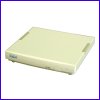| ABOUT | PRODUCTS | OEM OFFER | SERVICES | REALIZATIONS | CONTACT US | |||
| Main | ||
| Description | ||
| Technical data | ||
AVT 520
Alphanumeric terminal for UNIX and QNX systems
Very high real performance of the terminal Terminal operates on serial connection at a rate of 150 to 115200 bauds. Having only 'pure' text, without control sequences, it may work without synchronization - even at a rate of 57600 bauds, which is an outstanding result in comparison with other terminals. Variety of keyboards The terminal works with PC keyboards (EPC, PC-AT) with 4 different key maps. In the 'setup' mode user may see the present key layout e.g. national language keys' layout that are inscribed in a key map of the module used in reality. It occurs to be a great help when we have to work in a national language, using characters that are not described by the keys. The terminal gives unique possibilities of keys' redefinition (each key may occur in 12 combinations with modifiers and it may be treated as a character key in one combination and a function key in the other at the same time). Moreover, user may store his own definitions of 45 different keys. 'Setup-menu' contains an editor that enables a manual defining, whereas in VT, SCO and WYSE modes, appropriate sequences for remote programming can be found. Variety of available character generators The terminal has a rich set of embedded character generators that enable work with the following languages: English, German, French, Polish, Czech, Slovak, Hungarian, Russian, Ukrainian - 47 generators in sum (DEC-compatible mode: 13 of 8-bit and 6 NRC, SCO-compatible mode: 25 of 8-bit). There is also a possibility of external array uploading. Characters in the present active generator layout can be seen at any moment by entering the 'setup-menu'. The characters' style can be chosen between: one-pixel (default in WYSE emulation) or two-pixel (default in any other mode). Any announcements or warnings (e.g. that the printer is not ready) are shown in one of the chosen languages: Polish or English. Password protection against leaving the Screen-saver mode In the terminal a screen saver can be protected with password. Moreover, there is a possibility to blank (hide) the screen at any moment - manually or remotely by internal function call. This function protects the user's work from unauthorized changes when he's not present. The terminal gives a possibility to protect an access to 'setup-menu' by the password defined in SET-UP. Such a protection eliminates errors that may occur when the terminal works and the operator unintentionally enters the SET-UP and changes the settings. The terminal can be configured in two ways: a) Manually - by means of a drop-down menu, which has a form of a tree. The present terminal settings can be checked in 'setup' screen. These settings can be checked and saved at any moment in EEPROM memory of the terminal. Work with 'setup-menu' is an interactive activity, but the terminal recognizes the inserted settings and modifies the other ones (necessary for proper functioning) according to them. It should be underlined however that 'the last word' may belong to the operator. The terminal warns against unconventional settings, but eventually allows them. This idea meets problems that are typical for Central and East Europe, where many applications (and even configurations of the system environment) are based on difficult to predict local norms. b) Remotely - by means of a script sent through the communication channel. A coding sequence can be transmitted not only by the computer, but also by the other terminal. The structure of the control sequences enables to 'receive' the settings directly form the terminal and then immediately use the back-sent report as a programming sequence. This function enables something similar to a cloning of the settings in a group of terminals. It makes the configuration of the system more efficient and eliminates accidental mistakes or omissions (especially with non-typical configurations that demand a specific setting of even dozens of parameters). All settings available in the 'setup-menu' can be also modified selectively by special control sequences. There is a large group of so called 'internal functions' (including some unique for AVT), available in VT, SCO and WYSE modes by a special order sequence. |  | ||||
Technical data:
| |||||
| © Arkana, 2003-06 |